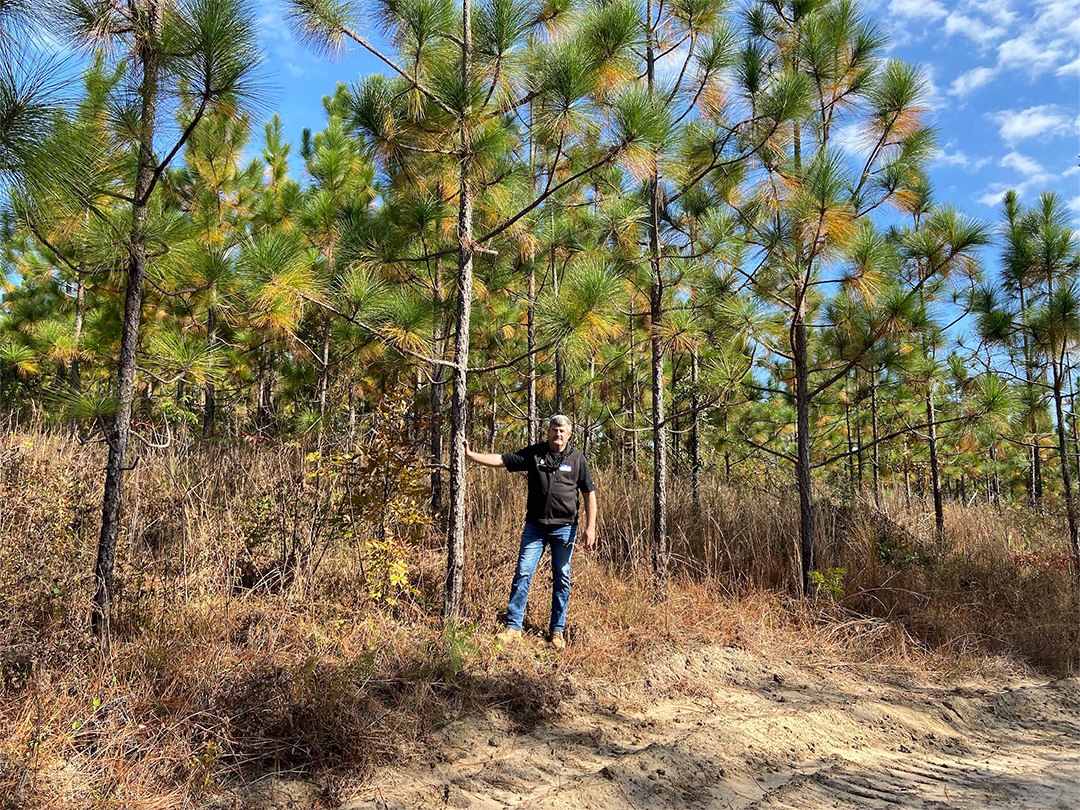For a long time, the longleaf pine (Pinus palustris) was the dominant tree species in the Deep South. At one time, the entire southern region of the United States was covered with this tree. And the longleaf pine was a very valuable tree, indeed. Early settlers and later developers of the region used the wood from longleaf pines for everything from construction to poles, posts, and even marine ship construction. Longleaf wood is strong, easy to cut and mill, and long-lasting.
And the native forest of longleaf pines is a thing of beauty. Tall mature trees make a very pleasing sound as the wind moves through the extra-long needles, and the small immature longleaf pines present a view like an army of little green furry creatures.
A wide range of native animals evolved to live in and with the longleaf pine.
Even though the longleaf pine population is only a shadow of its former glory, there are still stands of wild, native longleaf pines to be found growing in the South, and quite a few commercial nurseries start and grow longleaf pine seedlings for both commercial and recreational planting for landowners.
Characteristics of Longleaf Pine
Heavily logged during the late 19th and early 20th centuries, this native southern yellow pine once dominated the Southeast U.S. during the settlement period. It is often grown for quality saw timber, but also for quail and other wildlife habitats, and longleaf sites are cultivated for mulch straw baling production as intermediate income. It grows best on upland sites with some clay content. It is often planted on deep sands but tends to grow slowly on these soil types where sand pine may perform better. Like slash pine, nearly 10 percent of the seedlings planted in the Southern U.S. are longleaf pine.
Longleaf pines are slow starters. For the first few years whether growing from seed or from seedling planting, longleaf pines tend to look like clumps of grass. Although this grass stage is not impressive, it is at this stage of life that longleaf pines grow the strong root system which will sustain the tree for its relatively long life.

Once the longleaf pine reaches the vertical growth stage, it will grow as fast as most other species of pine- it’s just that slow “Baby Stage” which separates longleaf pines from other commonly planted species of pine.
Once established, longleaf pines are very fire tolerant, and a stand of these trees can benefit from a burn which helps clear competitive hardwood plants.
Environmental and Ecological Benefits of Longleaf Pine
Longleaf pines are a naturally occurring species that traditionally dominated the coastal and lower deep south region of the country.
A wide range of associated species from birds to reptiles to game animals evolved to live in the longleaf pine forests, and with the loss of so much of the longleaf pine coverage, these associated species have suffered.
A mature longleaf pine forest is particularly beneficial to game animals such as bobwhite quail which find the low weed and herb growth of species of plants that live under longleaf pines very beneficial for food and nest cover.
Evaluate Your Property
Since longleaf pine seedlings will prosper and do much better in a cleared soil condition, landowners should plan on either burning or using chemical herbicide chemicals to clear the competitive herbs and woody plants that are already in place on the site.
The cost of controlled burning can range from around $10 per acre to $50 or more. Landowners should carefully consider whether this cost is necessary to get a quality planting job. Often, spending this money on weed control and improved genetics is a better choice, simply by investing a few more dollars per acre. Controlled burning can be a valuable tool but consider if it is essential and review all of your options that could be better investments in the long term.
Site Characteristics, Suitability, Climate Consideration
As noted earlier, this variety is intolerant of competition from leafy hardwood vegetation, and a planting site needs to be thoroughly cleared either by burning or chemical application.

Longleaf pines tolerate drought better than many other pine species, and fire is beneficial for longleaf pines at nearly every life stage of the tree.
Longleaf pines evolved to tolerate the sometimes harsh conditions of the Gulf Coast and Deep South region, so as a species, it is much less likely to be damaged by naturally occurring weather and climate. Longleaf pine trees are not subject to strong wind damage, and as a species, longleaf pines are quite disease and pest-resistant.
Importance of Selecting the Best Pine Trees for Your Planting
Using the planning services of a good nursery such as ArborGen is a wise investment of time and money for any landowner considering planting longleaf pines. ArborGen does raise and sell longleaf pine seedlings for site planting, and the best idea for a landowner who wants to find out more and get pricing and seedling availability is to contact ArborGen and make arrangements to work with one of their advisors.
The Longleaf Alliance, a group dedicated to the preservation and continuation of native longleaf pine forests can also provide help in locating longleaf seedlings for planting. This organization is very helpful for landowners who want to learn more about this high-quality native pine tree and its growth patterns.

Identifying Your Goals for Pine Tree Planting
If planting a forest for future commercial income while also providing some benefit to game animals and other native animals, a stand of longleaf pine might be a good choice for landowners to consider. Be sure to consider all of your options, however, and have a look at some of our other writing on choosing the best pine seedlings for your property and goals.


